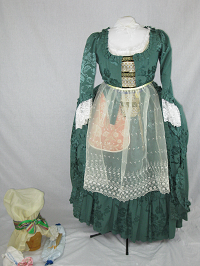1770s
Clothing was the showcase of your social status. By one or two glances you could tell how much money a man had. Clothing his wife, family and servants in the best he could afford was paramount to the English and French man who settled in America. Women displayed their handiwork for all to see in the guise of pockets, pocket books, and other accessories. Widows wore their embroidered pockets, aprons, and kerchief so the gentlemen could see their proficiency in this craft.
An apron kept her petticoat clean. Worn for support, the stays, or corset, pulled in the waist and flattened the front. To help with this, a busk was placed in a pocket down the front. These busks of wood or whale bone were handsomely carved, inlaid, and presented by a beau. The laces up the back allow for expansion. If you gained more weight, the sides can also be opened and laced. Bodices were cut very low so they devised ways to hide cleavage. Modesty vases, and bosom bows were placed center front.
Corset making was usually a man's profession because of the strength needed to stitch through the heavy materials. Made very narrow through the back, the stays forced the shoulders back into the position proper for the era. Beneath the corset, a bosom buddy acted like today’s underwire bra. It was made of linen stuffed with wool.
The hygiene of the 18th century included few baths. A woman carried a pomander to mitigate the inevitable odors, filled with lavender or spices from the garden. A wealthy woman could afford perfume from France. On the chatelaine with the pomander is a pin ball, key, needle case, and scissors.
An extra petticoat could be worn and pulled up to look wide side to side. Petticoats were constructed of five widths of material approximately 105 inches in diameter. The side slits allow access to the pockets beneath. When the bottom became ragged, a tuck could be let down.
Beneath the corset and petticoats is a chemise. It was constructed without a pattern of three rectangles. One extends from the hem in front up across the shoulder and down to the hem. The other rectangles are the sleeves. Gussets under the arms allow more freedom of movement and a drawstring adjusts the neckline to fit any gown. Stockings were hand knit and held up with garters. Shoe buckles were one of the first pieces of jewelry a woman would acquire and made of gold, silver, brass, or pewter. When a shoemaker was not available, clogs were more durable.
This fancy gown would be appropriate for a grand ball. Underneath is a blue chemise of polished cotton, with a blue ribbon girdle. From it hangs a chatelain with such necessities as a key, needle case and pomander containing a perfumed ball of cotton. During the 18th century, the chemise was not only worn as a morning dress but also as a nightgown and under other garments. It was constructed of 3 rectangles. The largest one extends from the hem up over the shoulder and down the back. This rectangle was shaped by taking a triangular piece from the shoulder area and adding it to the bottom of the skirt. The sleeve rectangle was attached with a gusset set under the arm for ease of movement. The neck is gathered and the lace frill is called a tucker. The sleeve ruffles will show under her gown. No other garment was worn under the chemise except on cold days. An extra petticoat was added and tucked in at the waist. Could this be the hint of bloomers to come?
Hoops have taken many shapes over the years. These are small and will hold the dress out at the side, while giving a flat figure from front to back. Whale bone or oak splits were used as stiffening. Another figure enhancer was the bosom buddy, or chest protector. Stuffed with wads of wool it added warmth in winter as well as curves.
This style of dress was popular from 1750 to 1785, and was called Robe à la française by the French. The original gown would have been laced up the back but for convenience we have added a zipper. Materials have been researched and while sometimes it was impossible to obtain the original material, cloth was selected that was as close as possible to the original in texture and design. The chemise lace is pulled out and is now the decoration for the robe. The same chemise might be worn under different style necklines by adjusting the drawstring in the neck. This gown gives a pleasant effect with its narrow waist, wide hips, and a train that falls from the shoulders. About the time of the American Revolution, the hair styles were so extremely high one lady went to a ball with her head out the carriage window. Because of the time needed to install rats, wads of wool, curl the hair and apply grease and powder, my lady might wait a month before having her hair re-styled. A head scratcher was a necessity. Head coverings were worn at all times, and differed with each activity. Mob caps were popular and as hair styles became more elaborate the caps became larger. This one of blue organdy has a hand-tatted edging and a white satin bow. A bit of neck lace and fingerless mitts of lace complete the look. A long purse and a cape complete the ensemble.
Click photo for detailed views.


